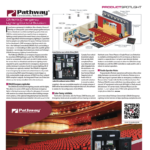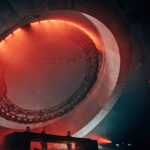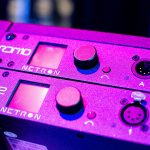Compulite is an Israeli-based lighting console manufacturer that has been in business for over 25 years. During the last few years, the company has expanded its range to include several new models. The Compulite Vector now comes in four models that vary according to how many faders and DMX512 outputs you need for your purposes. The company also manufactures programming wings and playback wings that can be used with an outboard PC. The playback wing can be used in conjunction with any model to add an additional 10 faders and cue keys. We had an opportunity to Road Test the Vector Red.
We’re assuming that you know a thing or two about programming lighting cues. This console does all the basic things all moving light and conventional desks do, but I am going to concentrate on all the extra functions that make this console stand out from the rest of the desks on the market.
Hardware
This big red console is slick looking. There is a programming keyboard on the right side, and on the left are 20 motorized faders. Each fader comes with a select (choose) button and three user-definable momentary buttons. Above each fader is another cue key. These are basic executor buttons that can run a faderless cue or macro or anything you assign it to do. The legends for each fader are located directly above each fader and cue key on the touch-screen monitors.
Above the faders are three full-color touch screens that individually fold down to cover the rest of the console. If you decide to go to lunch, you can simply close the screens to protect the console. You also can add three additional external monitors. Above each touch screen are fully loaded white LED strip lights that bathe the entire desk in light so you don’t have to bother focusing goosenecks to find buttons when the house lights are out. It’s about time someone did this! There are also two goosenecks included that can be used to light paperwork or a laptop off to the side of the console.
The two bigger models come with eight hard-wired DMX512 outputs via XLR connectors. Additional DMX512 universes are also available through an ePort, Compulite’s outboard Ethernet-to-DMX converter. Each box contains four more universes, and the console can run up to 32 universes simultaneously. The Vector also will support ArtNet.
There are five encoder wheels for programming moving light attributes, and they are divided into six categories: intensity, color, position, image (gobos), beam size and shaper (shutters or beam shaping). You can save your show files on a USB stick, CD or floppy disk.
You can interconnect two consoles and designate one as a master and one as the slave, and the slave will track the playback of the master. Should the master lose power, the slave automatically takes over control. The operating system uses a combination of a high-priority real-time application that handles all the calculations of the desk and a Vector console application that runs under Windows XP embedded, which handles all the displays and GUI. The Red console comes equipped with the console version of WYSIWYG. The smaller Vectors can run WYG as well, and for a minimal cost, these desks can come bundled with WYSIWYG console edition as an option.
Cool Features
Finally, someone has made a console with user definable screens. The user can size each view, such as the palette windows. The cue list screen can be set up however you like with fade/delay times, macros and cue names in whatever order, size, color or font you desire. This feature is also useful for live output and channel displays.
The patch is standard and simple. But what’s cool is that you can invert pan/tilt or change a fixture’s DMX512 channel without ever opening up the patch window. Changes are done on the “editor toolbar,” and the patch will mimic these changes. It saves a lot of time not having to reopen the patch to invert lights when you’re punting on a one-off. There is also a very easy and handy device builder on board. You can build and edit you own fixture libraries in under a minute with minimal info from a lighting manufacturer. It is incredibly simple and long overdue. You can add or swap fixtures to a show and clone the palette/cue info from other fixtures easily.
The palette layouts are typical, but if you would rather view them in a spreadsheet, it’s easily done. This is good for programmers like me who prefer the keypad to the touch screens. You can write a scene by pressing “group five, color two, position six, at full.” The palettes can be typical; telling one fixture to mix “red” will enable all fixtures of this type to go to the same values. You can also build what are called pattern library palettes. For example, you can take Fixture 1 and send it to red, Fixture 2 to white, and Fixture 3 to blue and record it to a palette. Then, when you grab all your fixtures and hit that palette number, every third light will be red, white or blue in sequential order.
The faders are big and move smoothly. Each fader can have its own priority level over any other. You can have 20 faders up at once, but whichever has the highest priority will take charge until it is pulled down or released. You can choose to group playbacks together, so executing one playback will automatically execute another playback. Should you decide that you never want to execute a strobe playback without executing the playback that turns all movers to black, it is easily done by linking the two playbacks.
The console has the capability to build inhibitive faders or the faders can be used to set up chase speeds in the cues under them with a simple button push. The cue lists on this desk are full tracking. If the operator jumps ahead five cues in a list, the console will act as if the previous cues have been activated.
There is a fader function called solo, which is very useful. For example, if you have five faders running different cues simultaneously and you need to view the output of just one to see which fader to edit, you simply select a fader and press “solo.” All the fixtures in the other cues will lose their info and black out, enabling you to edit the correct fader. Removing fixture info from any cue is simple and fast. The update function works flawlessly on this console.
The Vector takes the “high lite” feature to the next level by adding a “low lite” function, both of which are user definable. High lite will typically turn a fixture to full, make it white and remove any gobos when it’s active. Low lite takes a group of fixtures and prepares them for focus by presetting them in a certain look. For instance, suppose I grab a group of lights and make them blue with a medium zoom and 50% intensity and then record those as my low light attributes. Now, if I want to focus a big fan look, I can grab a group of fixtures, send them to the focus position and press “low lite.” When I press the “next” button to grab the first light of the group, the “high lite” attributes will bounce through my “low lite” attributes one fixture at a time. So I will see all my lights on at 50% in blue, but only the currently selected fixture will be at it’s “high lite” or “open white” settings.”
Snap pages are pages that take a snapshot of the desk and remember the state of each cue list and the levels of the motorized faders. There is a palette for snap pages and you could use these to change the setup for each song in a concert or scene in a TV show.
There are seven different edit layers you can work in simultaneously. Say you are programming a scene and the stage manager yells at you to bring up some Fresnels for work light. You don’t want to press Clear to bring up the Fresnels, but you don’t want to record them in the current scene you are building. Simply switch to another editor and turn on the damn work lights, then go back to your current editor and continue to work on your scene without worrying about them anymore.
Typically, you get just one “home” cue per show, which is what you use to define all your pan/tilt, color and beam default values. In the Vector, there is also a dedicated Home key with some unique features. Let’s say you are writing a big complex scene and you’ve got iris, frost, focus and zoom all at different value,s and it is starting to look like mush. You can always just grab the fixtures, and press “Frost + Home” or “Focus + Home”, and the parameter will go back to its home value.
The effects engine is pretty typical with the exception of one clever item; you can adjust the”swing” of an effect, which is not to be confused with the size attribute of an effect. The swing will alter the base position to suit you. For instance, if you have a tilt bally swinging out into the audience, but the lights keep tilting too far upstage onto a cyc, you can adjust the swing so they will still tilt the same amount, but never go back into the cyc again. There is also a very cool feature called sync with which allows you to sync two or more parameters together in the effects engine. This makes complex effects like “falling up” very quick and easy. Effects in any cue can either be turned off in the next cue or left alone while the base of the fixtures is changed.
Along with the effects engine is a function called “matrix,” which is useful with a wall of lights or LED fixtures. By grabbing the LEDs and selecting matrix, a window opens up that allows you to grab certain fixtures that are mapped to an image like a light plot, via a finger touch, or by odd numbers, thirds, etc., and change their attributes.
Split timing values are easily adjusted by fixture parameter in each cue. It takes mere seconds to grab all the lights and type in, for example, a color fade of two seconds, a position fade of five seconds, an intensity fade of zero, and record it into a cue.
Each parameter has its own hard key associated with it, allowing you to grab and extract single parameters easily. You can also use these hard keys to enter value levels for parameters like “cyan @ 60% enter.” Double pressing a gobo parameter hard key will bring up JPEGs of every gobo in a fixture on another screen. JPEGs of custom gobos are easily imported thru the USB connection and any JPEG can be used with any palette. Imagine taking pictures of your moving lights in different focus positions. Now every time you grab your lights and send them to the “apron wash” position, a JPEG shows up on the console showing you what the focus should look like on stage. It’s a useful tool for truss moves as well.
All in all, I feel the extra functions on this console make it one of the leading moving light consoles this year. After a rigorous test, I could find little that this console could not do. There are a few minor things like tap synch chase times that it doesn’t have, but that are currently being addressed by the manufacturer. The list price for the large console is comparable to other leading moving light desks currently on the market. The extra universe Ether-DMX boxes list for a mere $1,665.00 each. The entire Vector line can be viewed at www.compulite.com.
What it is: Full-featured automated lighting console
Who it’s for: Professional automated lighting programmers in touring, broadcast, corporate events, and more
Pros: User-definable screens, editor toolbar with patching, palette spreadsheet, playback grouping, solo, low lite, snap pages, seven edit layers, dedicated homing key with features, swing, matrix, position JPEGs, and more
Cons: Minor features still being added
Retail Price: $39,339


